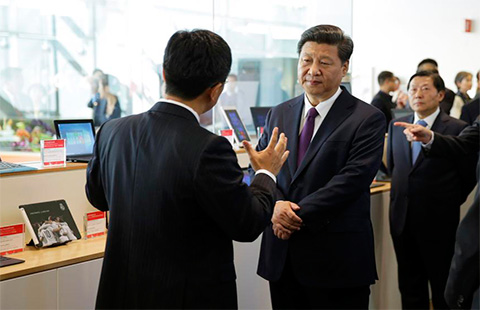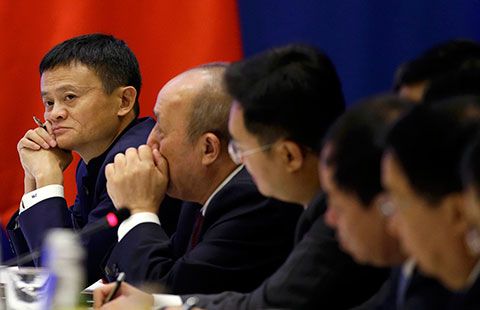Ethnic equality, unity and development in Xinjiang
Updated: 2015-09-25 06:33
(China Daily)
|
||||||||
III. Constantly Strengthening the Foundations of Development
Over the past six decades, Xinjiang's economy has achieved steady and rapid development, which has accelerated the region' s modernization and laid a solid foundation for improved standards of living and progress in various social programs.
Marked improvement has been observed in Xinjiang' s overall strength. Its gross regional product (GRP) was only RMB1.2 billion in 1955 and RMB3.9 billion in 1978. In 2014, it reached RMB927.3 billion, a 116-fold increase over that of 1955 in real terms, with an annual growth rate of 8.3 percent, or 0.2 percentage point higher than China' s average during the same period. Over the years between 2010 and 2014, the average annual growth rate of Xinjiang's GRP was 11.1 percent, 2.5 percentage points higher than the national average. It ranked the fourth of all the country's province-level divisions - its highest ever placing as compared to the 30th in 2009. Xinjiang's per-capita GRP rose to RMB40,648 in 2014 from RMB241 in 1955, about a 24-fold increase in real terms, and a 5.6-percent annual growth. Xinjiang's fiscal revenues and expenditure, no more than RMB170 million and RMB180 million in 1955, grew to RMB128 billion and RMB332 billion in 2014. Over the period from 2010 to 2014, Xinjiang collected a total of RMB454 billion in fiscal revenues, and spent a total of RMB1,308.8 billion.
The gap between urban and rural areas has gradually been narrowed. When the Xinjiang Uygur Autonomous Region was founded, it had only few cities like Urumqi, Kashi (Kashgar), Yining (Ghulja) and Hami (Kumul). Its rural areas remained a closed natural economy. There was a yawning gap between urban and rural areas. After six decades of construction and development, enormous improvement has been observed in the production and living conditions of both urban and rural residents. The ratio of urban to rural population was 15.1:84.9 in 1955. By 2014, it had changed to 46.07:53.93. The ratio of urban residents' income to that of rural residents decreased from 3.2:1 in 2009 to 2.7:1 in 2014, narrower than that in the 11 other provinces and autonomous regions of western China. As Xinjiang's new model of urbanization develops fast, more and more rural residents are moving to the cities and enjoying a modern city life.
The economy of the various areas of Xinjiang is developing in a coordinated way. For historical reasons and due to different conditions, Xinjiang's northern and southern parts, which are divided by the Tianshan Mountains, varied sharply in development. Following the launch of reform and opening-up drive in 1978, Xinjiang decided to first develop the economic belt along the northern slopes of the Tianshan Mountains. Development then extended to other parts and propelled the economic growth of the whole region. In 2014, the gross product of the economic belt reached RMB638.7 billion, accounting for 68.9 percent of Xinjiang's total. The state and the autonomous region have also attached great importance to the development of southern Xinjiang, which is mainly populated by ethnic minorities. Since 2010 in particular, Xinjiang has actively encouraged the development of the southern Xinjiang petroleum, natural gas and chemical industry belt and made strenuous effort to support the development of poverty-stricken areas there by giving them a high priority in funding and projects. The average economic growth rate of the four southern Xinjiang prefectures (Hotan, Aksu and Kashi prefectures, and Kizilsu Kirgiz autonomous prefecture) increased from 10.5 percent in 2009 to 11.2 percent in 2014. A steady growth has been seen in the economic strength of southern Xinjiang, so has a constant improvement in the local people's standards of living.
- Another corruption suspect repatriated from US to China
- Shanghai slaps three-year ban on entertainers caught doing drugs
- 37 students critical after botched fire drill in NW China
- Man writes Chinese calligraphy using kitchenware
- Brilliant Autumn Urumqi feasting many eyes
- Kids serve as traffic police in C China
- Colombia, FARC reach breakthrough agreement in Havana
- White House prepares for government shutdown
- EU leaders seek unity on refugee plans
- EU pushes through plan to relocate 120,000 refugees amid oppositions
- China, Malaysia conclude first joint military exercise
- Hillary Clinton opposes controversial oil pipeline

 Here's what's on the menu for the state dinner
Here's what's on the menu for the state dinner
 President Xi visits Microsoft campus in Seattle
President Xi visits Microsoft campus in Seattle-
 Xi revisits Lincoln High School after 1993 bond
Xi revisits Lincoln High School after 1993 bond 
 Chinese, US business leaders gather at roundtable meeting
Chinese, US business leaders gather at roundtable meeting-
 Xi visits assembly line of plane manufacturer Boeing in US
Xi visits assembly line of plane manufacturer Boeing in US -
 First Lady tours Fred Hutchson Cancer Research Center
First Lady tours Fred Hutchson Cancer Research Center 
 Boeing to sell 300 planes to China
Boeing to sell 300 planes to China-
 Sino-US ties need more understanding: Xi
Sino-US ties need more understanding: Xi
Most Viewed
Editor's Picks

|

|

|

|

|

|
Today's Top News
Young people from US look forward to Xi's state visit: Survey
US to accept more refugees than planned
Li calls on State-owned firms to tap more global markets
Apple's iOS App Store suffers first major attack
Japan enacts new security laws to overturn postwar pacifism
Court catalogs schools' violent crimes
'Beauty of Beijing's alleys akin to a wise, old person'
China makes progress fighting domestic, international cyber crime
US Weekly

|

|







